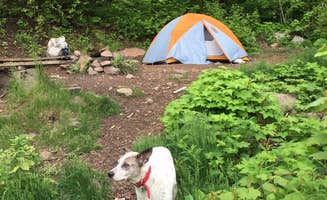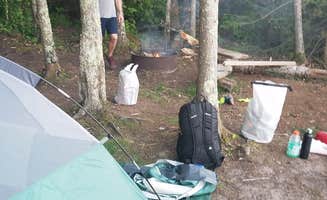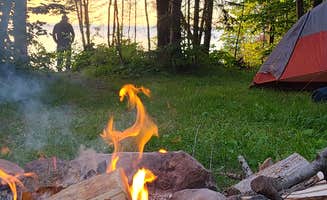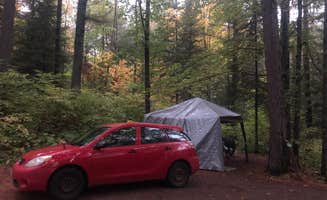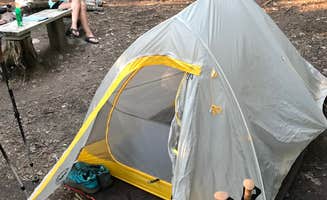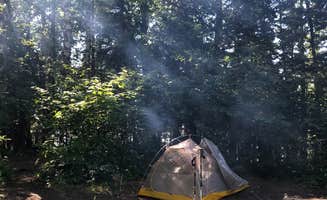Backcountry tent campsites near Knife River, Minnesota range from heavily wooded riverbank locations to rocky Lake Superior shorelines. The region experiences cold winters with heavy snowfall and mild summers with daytime temperatures averaging 70-80°F from June through August. Mosquitoes peak in June and July, particularly in inland wooded areas away from shore breezes.
What to do
Hiking to wilderness lakes: The Bean and Bear Lakes trail offers one of the area's most challenging but rewarding hikes. "This is one of my all time favorite hikes and camp spots 'up north'. The hike into the Bean and Bear Lakes is fun and has some great views in itself. Though the best and most gratifying part of the hike is getting to the top of the overlook and seeing both lakes," reports one visitor to Bean and Bear Lakes Hike-In.
Explore waterways: Thompson Beach Kayak Site provides direct access to Lake Superior for paddlers. "Beautiful campground," notes a visitor who rated the Thompson Beach Kayak Site highly, making it ideal for kayakers seeking backcountry camping with beach access.
Winter camping options: Unlike many Minnesota parks that close in winter, some backcountry sites remain open year-round. "This is one of the few state parks in Minnesota where you can winter camp! The trails are absolutely beautiful in the fall, the scenery changes often," explains a camper at George H. Crosby Manitou State Park.
What campers like
Riverfront solitude: Sites directly on rivers provide natural sound barriers and sensory experiences. A camper at George H. Crosby Manitou State Park Campground shared: "We stayed at site 13 and loved it. Site 13 sits on a ridge about a curve in the river and is completely secluded."
Scenic lake overlooks: Many campers praise the elevated views available from certain campsites. "The walk-in campgrounds here are fantastic. They are very spacious and private, located on a bluff on the edge of Lake Superior. Sleep to the sound of crashing waves. Scramble down the bluff to a virtually private beach," writes a camper about Bean and Bear Lakes.
Cart-in privacy: Cart-in sites offer a balance between accessibility and seclusion. A visitor to Lake Superior Cart-in Campground noted: "We stayed in site L for one night and had a great time! We could see lake superior and part of Palisade head from our campsite, which was awesome. Sites were fully hidden from each other, spacious, and comfortable."
What you should know
Variable terrain challenges: Many backcountry sites require significant hiking on difficult terrain. "The trails of this park are either a hikers dream or nightmare. Exposed roots, large rocks, and elevation changes are common. Good potential for a twisted ankle. I would not advise bringing small children or inexperienced hikers," warns a camper at George H. Crosby Manitou State Park.
Food storage considerations: Bear activity requires proper food management. Lake Superior Cart-in Campground provides "bear boxes at the site are also convenient so hauling food to the car at night is unnecessary, and the boxes are big enough to stash extra gear or valuables while you're not on site."
Campsite reservations: Most wilderness sites fill quickly during peak season. According to a visitor at Point Detour Wilderness Campground: "We were told that most of the time, you don't even need a reservation, but we were there on July 4th. Even so, there was still availability."
Tips for camping with families
Choose sites based on hiking ability: Some backpacking sites require strenuous hiking that young children may struggle with. "According to my GPS this is 138 feet of elevation. And remember what I said about the large rocks and exposed roots? This trail doesn't disappoint," cautions a camper at George H. Crosby Manitou about site 19.
Consider cart-in options: For families with young children, cart-in sites offer a middle ground. "We camped in the cart-in area and it was a blast! It was our first time doing the cart-in and was slightly hard, but you have to commit to this if you reserve," advises a camper at Lake Superior Cart-in Campground.
Look for camper cabins: Cloquet-Duluth KOA offers cabin options near the North Shore. "The cabins and tent area looked better. It was fine in a pinch but not my idea of camping," notes one visitor, suggesting these might be good alternatives for families wanting easier access to amenities.
Tips from RVers
Alternative to backcountry camping: RV camping options are limited in the immediate Knife River area but available within driving distance. One RV camper at Cloquet-Duluth KOA reported: "Grounds have a nice mix of RV spots out in the open as well as some RV and tent spots back in the trees with water and electric only sites. Full hookup sites are only out in the in the open spaces."
Consider time of week: Weekend crowding affects RV sites more than backcountry locations. "Easy access to Jay Cook State Park. Jay Cook has a lot to offer; a suspended cable walking bridge, great moderate hikes, waterfalls, climbing on rocks, and amazing river views. Great place to stop in for a couple hours or spend the whole day hiking," advises an RVer at Cloquet-Duluth KOA.


